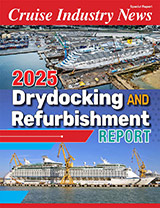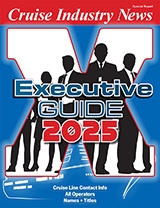In 1993, there will be a six percent decline in capacity in Hawaii, from 105,000 berths in 1992 to 99,000 in 1993.
Land Tourism
Hawaii as a destination has been hard hit by the recession. Often thought of as an expensive land destination, the Hawaiian Islands’ downward spiral of visitors has continued. While in 1991, there were 1.5 percent less land visitors than in 1990, the gap has widened to a five percent decline for the first eight months of 1992 compared to the same period in 1991.
Since these numbers take into account visitors prior to Hurricane Iniki, which hit the Hawaiian Island of Kauai in September, there will probably be an even greater decrease in the overall year-end figures. From June through August, there was a 20.4 percent decrease in westbound, or U.S. traffic.
According to Gene Ferretti, President of American Hawaii Cruises, land tourism was also hit by the early summer air fare wars which dramatically lowered domestic airfares, but not airfare to Hawaii.
Foreign-flagged Ships
As far as cruises are concerned, however, it seems as if the recession and the hurricane are not the major causes for less capacity in 1993. While 1992 fourth quarter bookings slowed down temporarily at American Hawaii Cruises in the aftermath of the hurricane, the main reason that there are less foreign-flagged ships and cruises to Hawaii next year is due to repositionings, including world itineraries which called in Hawaii in 1992 but are cruising to other regions in 1993. For example, both Crystal Cruises and Royal Viking Line have changed their world itineraries and therefore do not call in Hawaii as they did last year. Ships which are including Hawaii in their world cruises this coming season include Cunard Line’s 1,800-passenger QE2 and Holland America Line’s 1,114-passenger Rotterdam.
In addition, in 1993 Royal Cruise Line will have only the 1,054-passenger Crown Odyssey offering Big Band-themed cruises to Hawaii. Last year, due to the Royal Odyssey’s repositioning from the Far East, where she was refurbished, to the U.S., RCL offered Hawaiian itineraries on both ships.
This fall, Regency Cruises offered two Hawaiian cruises aboard the 729-passenger Regent Sea after the Alaskan season. Due to their popularity, the ship will also be offering sailings from Ensenada to Honolulu and from Honolulu to Vancouver next spring prior to the Alaska season.
Other foreign-flagged ships in the Hawaiian market this year include Princess Cruises’ 626-passenger Pacific Princess and 890-passenger Fair Princess, and Cunard’s 588-passenger Sagafjord.
Most ships depart from Ensenada, Los Angeles, or Vancouver and include a number of calls in the Hawaiian Islands prior to turning around in Honolulu or continuing to Papeete, Tahiti. Foreign-flagged ships departing from Los Angeles must call at Ensenada or Papeete in order to fulfill the U.S. Passenger Act requirement that foreign-flagged ships include a foreign port while sailing from one U.S. port to another.
Theme Cruises
Theme cruises, which feature special activities to occupy the days at sea between the mainland and Hawaii, are very popular. Once again, RCL is featuring a Big Band Grand Hawaii Swing Extravaganza on its Hawaiian sailings, which spotlights bands whose origins are from the 1940s era. Similarly, American Hawaii also features a “1940’s Remembered” cruise each December, which also ties in with the commemoration of Pearl Harbor Day.
Other American Hawaii theme cruises aboard the 798-passenger Constitution and Independence next year include Save the Humpback Whales, which allows passengers to whale watch and attend lectures; Classic Golf Clinic and Tournament, which features golf experts on board as well as the opportunity to golf on world-famous Hawaiian courses; and an Aloha Festival which highlights Hawaiian history and culture.
Hurricane Iniki
Due to Hurricane Iniki, which severely damaged homes, hotels, and roads on the island of Kauai, American Hawaii altered its seven-day itineraries to exclude Nawiliwili, Kauai. Instead, the Independence and Constitution stay overnight at Hilo, on the Big Island of Hawaii, as well as overnight in Kahului, on Maui.
“We’re anxious to return, once we know the island and port is safe and that the infrastructure can support our passengers; Ferretti said. “We feel we can add to the economic re-development of the island by bringing passengers back,” he continued.
While no final date has yet been set with the Hawaiian State Department of Economic Development, Ferretti said that American Hawaii is aiming for December 1, which is much sooner than most hotels on Kauai expect to re-open. Before then, a crane precariously hanging over the pier area must be removed, roofs of sheds in the docking area must be fixed, and infrastructure must be rebuilt. Ferretti said that presently the pier is being used for shipments of relief supplies.
Ferretti added that there must also be things for passengers to do on the island in order for the ships to return. While beaches may not be as scenic until foliage has grown back, Ferretti said that passengers can still take helicopter rides over Kauai’s Napali Coast and Waimea Canyon.
American Hawaii
Despite a few weeks of slower than usual bookings right after the hurricane – during which American Hawaii extended its 1992 rate freeze for 1993 cruises through September 30 – Ferretti said that the line has recently seen an increase and felt that Hawaii will see a rebound in 1993. “1993 is off to a better start than 1992, he said. While he said that recession is “still taking its toll” due to people trading a Hawaiian vacation for other lower-priced destinations, Ferretti said that “people who are still committed to going to Hawaii in 1993 will see the value of our cruises.” Ferretti acknowledged that while one cannot compare the price of a Caribbean cruise with the price of a Hawaiian cruise, he did note that Hawaiian cruises “are a bargain” compared to paying for a hotel, food, airfare, and tsland hopping when visiting Hawaii by land.
One of the company’s most successful incentive programs yet, according to Ferretti, is the recently introduced 1993 Early Booking/Full Payment Program. If passengers pay 50 percent of their fare at the time of deposit rather than the required 25 percent, they get a cabin upgrade. Ferretti said that this amounts to a $100 to $125 savings, depending on category.
While the majority of American Hawaii cruises are seven days, there are a limited number of three and four-day sailings available, which tend to attract many honeymooners and those with short vacation time. Ferretti said that American Hawaii cruises are true destination cruises since there is only one day at sea and port stays average 10 to 12 hours. There are 45 shore excursions which range from biking down a mountain at 3 a.m. to sedate bus tours.
Future Growth
According to Ferretti, American Hawaii has no immediate plans for growth. Part of the deterrent is that ocean-going cruise ships have not been built in the U.S. in years due to high costs. Therefore Ferretti said that the line will continue to put money back into refurbishing its existing ships.
While Congress passed a law earlier this year allowing American-flagged cruise ships to have gambling aboard, American Hawaii will not be adding casinos to its ships since the law allows for states to overrule, as Hawaii has.
Once the economy picks up, Ferretti feels that Hawaii as a destination will rebound due to the baby boomers coming of age and seeking active vacations such as those offered in Hawaii. However, in order for cruise tourism – American or foreign-flagged - to grow, Ferretti said that Hawaiian infrastructure must develop more. In Nawiliwili, prior to the hurricane, only one cruise ship could call at a time, and in Hilo, only two can call at a time. On other islands, he said there are limitations due to the lengths of the piers. There is much congestion since the islands rely heavily on container ship transport.
While Honolulu’s Aloha Tower waterfront is being developed, Ferretti said that new passenger terminals will not be built at every pier. This therefore limits the number of foreign-flagged ships which can call at one time.
The first phase will begin construction in April, 1993 and is set for summer of 1994 conclusion. The $100 million first phase will include a new cruise ship terminal at Pier 10, a retail “festival marketplace” similar to those in Boston and Baltimore, refurbishment of historic Aloha Tower, and parking. The cruise ship terminal will be capable of handling two vessels simultaneously.



